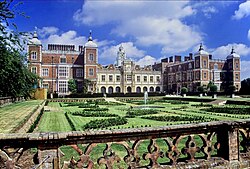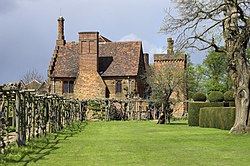Hatfield, Hertfordshire
| Hatfield | |
| Hertfordshire | |
|---|---|
 Hatfield House | |
| Location | |
| Grid reference: | TL234086 |
| Location: | 51°45’46"N, 0°13’42"W |
| Data | |
| Population: | 27,883 (2001) |
| Post town: | Hatfield |
| Postcode: | AL9, AL10 |
| Dialling code: | 01707 |
| Local Government | |
| Council: | Welwyn Hatfield |
| Parliamentary constituency: |
Welwyn Hatfield |
Hatfield is a town in Hertfordshire. It has old origins but is also a new town and bears the development of that age of post-war enthusiasm.
The nucleus of the Old Town is Hatfield House, the home of the Marquess of Salisbury and his ancestors since the days of Sir Robert Cecil, the First Earl of Salisbury, in the reign of King James I.
From the 1930s when de Havilland opened a factory until the 1990s when British Aerospace closed, Hatfield was associated with aircraft design and manufacture, which employed more people than any other industry.
Hatfield was one of the post-war New Towns built to take the London overspill and it has much modernist architecture from the period. The University of Hertfordshire is based in Hatfield.
History
Early history
In the Saxon period Hatfield was known as Hetfelle and became known as Haethfeld in around the year 970 when King Edgar gave 5,000 acres to the monastery of Ely. Hatfield is mentioned in the Domesday Book as the property of the Abbey of Ely, and unusually, the original detailed records which compilers of Domesday used still survives, giving us slightly more information than was recorded in the final Domesday Book.[1] No other records remain from that time until 1226, when Henry III granted the Bishops of Ely rights to an annual four-day fair and a weekly market. The town was then called Bishop's Hatfield.
Hatfield House and the Cecils

The original Hatfield House, now "The Old Palace" in Hatfield Park was built by the Bishop of Ely, Cardinal Morton, in 1497, during the reign of Henry VII, and the only surviving wing is still used today for Elizabethan-style banquets. St Etheldreda's Church was founded by the monks from Ely, and the first wooden church, built in 1285, was probably sited where the existing building stands overlooking the old town. It fell to the crown at the dissolution of the monasteriesa dn served as a royal residence. Princess Elizabeth was confined there for three years untl in 1558, while sitting under an oak tree in the Park, that she learned that she had become Queen following the death of her half-sister, Mary. She held her first Council in the Great Hall of Hatfield.
The Cecils came to Hatfield later. William Cecil served the crown from his youth to his death, from the days of King Henry VIII and rose in the reign of Queen Elizabeth I to be the Queen's most trusted adviser. On his death his son, Sir Robert Cecil, continued in the role and it was Sir Robert who in 1603 ensured the smooth succession of King James VI of Scotland to the throne of England at the Queen's death. The King rewarded Cecil with successive titles, ultimately making him Earl of Salisbury. In return for Cecil's seat at Theobalds, which he valued for its hunting grounds, the King granted Hatfield House. Ever since, it has remained the seat of the Earls and Marquesses of Salisbury.
The town grew up around the gates of Hatfield House. Old Hatfield retains many historic buildings, notably the Old Palace, St Etheldreda's Church and Hatfield House.
In 1851, the route of the Great North Road (now the A1000) was altered to avoid cutting through the grounds of Hatfield House. However, when the railways came, the Second Marquess of Salisbury, unlike many landowners, welcomed its passing through his estate as it would bring prosperity to the town.
Aerospace industry

In 1930 the de Havilland airfield and aircraft factory was opened at Hatfield and by 1949 it had become the largest employer in the town, with almost 4,000 staff.[2] It was taken over by Hawker Siddeley in 1960 and merged into British Aerospace in 1978. In the 1930s it produced a range of small biplanes. During the Second World War it produced the Mosquito fighter bomber. After the war, facilities were expanded and it developed the Vampire, Comet, the Trident airliner, and an early bizjet, the DH125.
BAE closed the Hatfield site in 1993. The land was used as a film set for Steven Spielberg's movie Saving Private Ryan and most of the BBC/HBO television drama Band of Brothers. It was later developed for housing, higher education, commerce and retail. Hatfield's aerospace history is recorded in the names of local streets and pubs (e.g. Comet Way, The Airfield, The Harrier).
New Town

After the Second World War, Hatfield was designated a New Town under the New Towns Act 1946 (to implement the Abercrombie Plan for London written in 1944). It formed part of the initial Hertfordshire group with nearby Stevenage, Welwyn Garden City and Letchworth. The Government designated 2,340 acres for Hatfield New Town, with a population target of 25,000.[2] By 2001 the population had reached 27,833.[3]) The Hatfield Development Corporation, tasked with creating the New Town, chose to build a new town centre, rejecting Old Hatfield because it was on the wrong side of the railway, without space for expansion and "with its intimate village character, out of scale with the town it would have to serve."[2] They chose instead St Albans Road on the town's east-west bus route. A road pattern was planned that offered no temptation to through traffic to take short cuts through the town and which enabled local traffic to move rapidly about the town.[2]

Hatfield retains New Town characteristics, including much modernist architecture of the 1950s and the trees and open spaces that were outlined in the original design. The redevelopment of the town centre is being planned, involving the construction of 275 flats and retail units.
Culture and recreation
Hatfield has two public swimming pools, two sports/leisure centres, a nine screen cinema, a factory outlet shopping centre situated above the A1(M) called The Galleria and two supermarkets in the town centre and one at the northern end of the town.
Sights about the town
- Hatfield House.
- Mill Green Museum and watermill